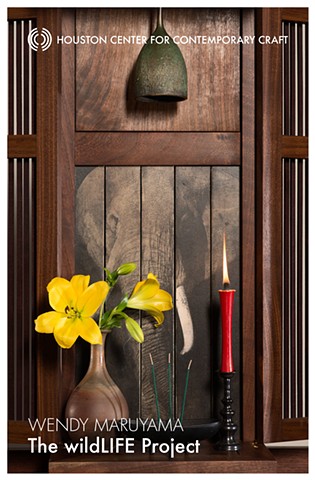Exhibition Announcements
Houston Center for Contemporary Craft (HCCC) is pleased to present Wendy Maruyama: The wildLIFE Project, an exhibition that serves to illustrate the plight of elephants and the illegal ivory trade. Through a moving installation of life-sized objects made from exotic woods and string and shrine-like forms made from steel and glass, the show makes a compelling case for the preservation of animals in the wild.
Furniture maker, artist and educator Wendy Maruyama has been making innovative work for 40 years. While her early work combined ideologies of feminism and traditional craft objects, her newer work moves beyond the boundaries of traditional studio craft and into the realm of social practice. The wildLIFE Project focuses on the endangerment of elephants, a cause that is very personal to the artist. She recently took a sojourn to Kenya and met with wildlife advocates to investigate the dangers of the continued poaching of these magnificent animals. The trip served as a source of inspiration for the artist to create a new body of work and incorporate a strong societal message.
The elephant is memorialized in monumental form in The wildLIFE Project. The heads range from eight to 12 feet in height and are constructed from panels of wood, tied together with string. Their surfaces are finished in various earth tones, from grey to brick red, and some reach 12 feet in height. Maruyama adapts the Buddhist ritual of honoring the dead and examines the meanings of different components of the Buddhist altar or obutsudan. In this context, the central object of reverence or worship (Gohonzon) is the elephant—tortured, killed and driven, almost to extinction, by man. Flowers are used to represent the impermanence of this gentle and majestic animal. A candle is placed on an altar to symbolize unchanging truth. Incense is burned as an offering in an attempt to capture the spiritual state in the present moment. A wooden reliquary is made to house large hand-blown glass tusks, symbolizing the preciousness of both the elephant and the ivory for which it is sourced. (Maruyama was an artist-in-residence at Pilchuck Glass School in May, 2013, and worked with professional glass blowers for these pieces.)
In recent years, Maruyama’s work has taken a narrative direction—integrating images and text into shrine-like cabinet forms—which adds an additional layer of sensory experience for the viewer. Her “shrines” are constructed from various woods, steel and glass–raw materials that transfer emotion. Steel is immovable, permanent, and heavy; glass is fragile and opaque when stacked together. The installation further engages the viewer’s senses through the use of video, incense and a bronze bell set to ring throughout the day. All of these components help make the viewer feel like a participant in a sacred ritual.
Former HCCC Curator Elizabeth Kozlowski has been following Maruyama’s work for many years. She says that the artist views this body of work not only as an art project but as an advocacy tool—one that brings communities together for a common purpose. “The social-practice component of her artwork is successful in combining art, advocacy, education and community. Her work manages to pull you in with stirring visuals and keep you engaged with multiple layers of content. ”
Following its premiere at Houston Center for Contemporary Craft, The wildLIFE Project will travel to four venues through 2017: Center for Art in Wood (Philadelphia, PA), Feb – April 2016; Penland Gallery (Penland, NC), July – Sept, 2016; Chrysler Museum of Art (Norfolk, VA), Sept 2016 – Jan 2017; and San Francisco Museum of Craft and Design (San Francisco, CA), Jan -May 2017.
The wildLIFE Project is made possible by generous support from the Windgate Charitable Foundation.
